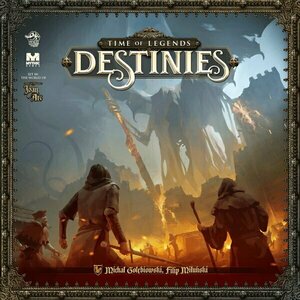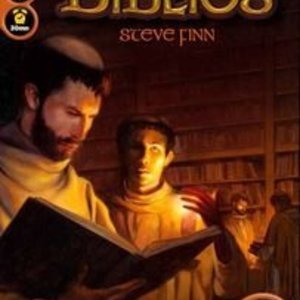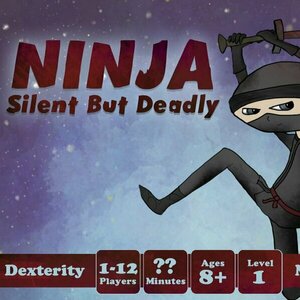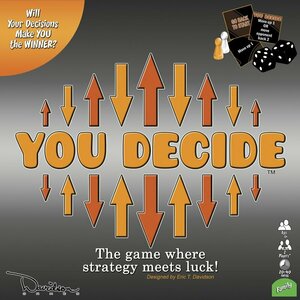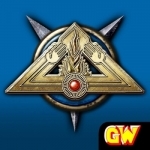Search
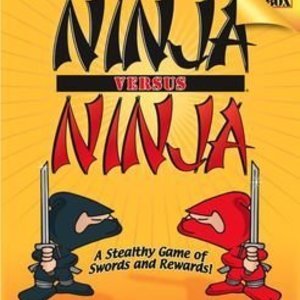
Ninja Versus Ninja
Tabletop Game
A Stealthy Game of Swords and Rewards Your Ninjas must defend the honor of their dōjō against a...
BoardGames NinjaGames
Purple Phoenix Games (2266 KP) rated Destinies in Tabletop Games
Jan 29, 2022
I can recall so many instances of my board game purchases being based on either the designer, artist, or publisher. Surely I am not alone here. Josh will probably always be a Stonemaier Games fanboy. Laura has aligned herself with Daily Magic Games and Button Shy Games. While I am a big fan of the Valeriaverse, I think my current preferences put me on teams Weird Giraffe Games, Blue Orange Games, and Lucky Duck Games. Speaking of the latter, LDG have come through with some seriously excellent hybrid app-driven games that just wow me every single time. I was definitely a hybrid game naysayer when the first Chronicles of Crime came out, but the more I play them, the more I appreciate the accomplishments. Destinies has now come along to me and it has been some time since I have been this jazzed to play a game over and over and over and over.
Destinies is a hybrid app-driven adventure board game for one to three players. In it, players will be choosing their characters and how to play them, along with the path of their individual destinies across several campaign scenarios. When playing multiplayer, the player who completes their destiny first will win. When playing solo (which is also amazing), the player wins when they successfully complete their destiny.
DISCLAIMER: We are using the Kickstarter version of the game. We do have the expansions from the KS campaign, but will not be using those for this review. Also, we do not intend to cover every single rule included in the rule book, but will describe the overall game flow and major rule set so that our readers may get a sense of how the game plays. For more in depth rules, you may purchase a copy from the publisher directly or from your FLGS. -T
Usually I list out the steps to setup a game in this section, but there are so many little items and steps to be taken that I will simply show you, the reader, how a scenario may look once setup. The app will instruct players how to create their character’s stats and which map tiles should be placed out initially. Typically, though, each player will receive a player board, Destiny card (with their character headshot on one side and their Destiny choices on back), two main dice, three effort dice, and one gold coin. Once setup, the app will drive the story along and the players will be rolling dice and making choices in order to win the game or scenario.
Each player will be given their Destiny card with two distinct Destiny paths on the backside. These paths correlate with the current scenario, and the player will be able to choose one of the two given paths to help move their games forward. However, sometimes players will switch their Destiny mid-game due to several factors including successes on previous tasks or current inventory. The only way to win the game is to complete a Destiny, so staying on track is paramount in this open sandbox game – it is incredibly easy to become sidetracked and lose sight of specific tasks to be performed.
Each turn a player may move to a new tile, to previously-explored tiles, or points of interest on specific map tiles. These points of interest could be unique characters to be visited, or more general spaces on the tile represented by tokens. Sometimes visiting a POI (point of interest) will have the player rolling dice to complete tests, initiating trade with the POI NPC, revealing information about their distinct Destiny, or even issuing side quests. Players take their chances by visiting a POI because only one may be visited on a turn. Once a player has moved and visited a POI, their turn is over and the next player’s turn begins.
The most interesting aspect of this game is the experience tracker and results of tests. Player stats are divided between Intelligence, Dexterity, and Power (Strength for my D&D readers). These stats are constantly in flux due to tests and experience, and levels range from 1-12+ on the player board. A player will roll both main dice and any effort dice they wish on each test, and the total result is compared to the discs present on the main player board. One success is counted for each disc’s value equal to or below the rolled result. For example, if the roll is a 6, and the player has a disc on 3 and another on 6 the player counts two successes. Effort dice add values to the rolled result, and one side of these dice depict a star, which counts as one success. Throughout the game players will be moving their skill marker tokens (discs) up and down the tracks. Sometimes this is due to a test being failed or succeeded, but sometimes experience tokens are earned. A player may improve their skill levels by two total values on the tracks for each experience token discarded. Players may choose which tracks, and may maximize their character’s skill or spread out the experience across multiple skills.
Play continues in this fashion of referencing the app for story and plot items, players working toward completing their Destinies, and adventuring across the land rolling tests and improving skills until one player finishes their Destiny and wins the game!
Components. As always, I am going to be honest here by stating I believe that Destinies packs the box with the best components I have seen in a game. The multi-layered insert is perfectly formed and well-thought out, all the cardboard tokens are super-thick, the dice are so fun to handle and roll, the cards and other components feature incredible artwork, and did I mention there’s about a thousand minis in this game? I am reluctant to even call some of these things minis as they are large and in charge for SURE. I have zero complaints or comments on the components present in Destinies. Lucky Duck knocks it out of the park once again. Incredible.
I actually backed this one on Kickstarter just because it comes from Lucky Duck Games. I had played Chronicles of Crime and loved it, and just wanted to try something different but using a similar system. Typically I don’t keep up with the comments and updates to a game I have backed because I enjoy being surprised by the product that arrives at my door. Destinies was certainly a surprise to me, and I have been kicking myself in the butt for not getting it to the table the very first day I received it.
Destinies is my favorite Lucky Duck Games title, and that is saying a ton, as I rave about every game of theirs I have played. I hope you all back me up here, and if you haven’t yet tried this one, I hope you visit your closest friend or board game cafe that owns it. The tutorial scenario is great, and the campaign scenarios have been awesome so far. Okay, yes, when I first played it with Laura, my wife made several comments about it being a 3 hour game, but once that first one is completed, the subsequent plays run much smoother.
What I love so much about this is how indefinitely expandable it is. Most of the components are multi-use (akin to all the character cards in the Chronicles of Crime games), and can be used in campaign after campaign. The drawbacks I see for this, though, is any sort of waning interest in it forcing designers to abandon plans to create more scenarios. Could a new scenario pack be an acceptable expansion versus a large expansion box with oodles of new components and minis? I think so, but I am no designer. Could the Millennium Series treatment be given to Destinies? Absolutely! This system does not need to be played in a medieval fantasy world. It could be molded to almost anything, and that gives me excited shivers over the future of this game.
If you are anything like me and have now embraced the hybrid gaming trend, I highly recommend Destinies. I plan to also review all the expansions in the near future, so do look out for those, but please do yourself a giant favor and pick up Destinies. The excellent storytelling, great components, and just amazing fun helps Purple Phoenix Games give this one a perfectly deserved 12 / 12, and a Golden Feather Award! I can’t stop thinking about it and how I would play it differently next time, and hopefully after I have played through the expansion material I will be able to restart from the very beginning with different characters and choices. It’s a sign of a great game when I can’t stop thinking about it, and I do believe Destinies currently is knocking at the door of my Top 10 Games of All Time. No, it’s there. It’s totally there. TOP 10 BABY!!
Destinies is a hybrid app-driven adventure board game for one to three players. In it, players will be choosing their characters and how to play them, along with the path of their individual destinies across several campaign scenarios. When playing multiplayer, the player who completes their destiny first will win. When playing solo (which is also amazing), the player wins when they successfully complete their destiny.
DISCLAIMER: We are using the Kickstarter version of the game. We do have the expansions from the KS campaign, but will not be using those for this review. Also, we do not intend to cover every single rule included in the rule book, but will describe the overall game flow and major rule set so that our readers may get a sense of how the game plays. For more in depth rules, you may purchase a copy from the publisher directly or from your FLGS. -T
Usually I list out the steps to setup a game in this section, but there are so many little items and steps to be taken that I will simply show you, the reader, how a scenario may look once setup. The app will instruct players how to create their character’s stats and which map tiles should be placed out initially. Typically, though, each player will receive a player board, Destiny card (with their character headshot on one side and their Destiny choices on back), two main dice, three effort dice, and one gold coin. Once setup, the app will drive the story along and the players will be rolling dice and making choices in order to win the game or scenario.
Each player will be given their Destiny card with two distinct Destiny paths on the backside. These paths correlate with the current scenario, and the player will be able to choose one of the two given paths to help move their games forward. However, sometimes players will switch their Destiny mid-game due to several factors including successes on previous tasks or current inventory. The only way to win the game is to complete a Destiny, so staying on track is paramount in this open sandbox game – it is incredibly easy to become sidetracked and lose sight of specific tasks to be performed.
Each turn a player may move to a new tile, to previously-explored tiles, or points of interest on specific map tiles. These points of interest could be unique characters to be visited, or more general spaces on the tile represented by tokens. Sometimes visiting a POI (point of interest) will have the player rolling dice to complete tests, initiating trade with the POI NPC, revealing information about their distinct Destiny, or even issuing side quests. Players take their chances by visiting a POI because only one may be visited on a turn. Once a player has moved and visited a POI, their turn is over and the next player’s turn begins.
The most interesting aspect of this game is the experience tracker and results of tests. Player stats are divided between Intelligence, Dexterity, and Power (Strength for my D&D readers). These stats are constantly in flux due to tests and experience, and levels range from 1-12+ on the player board. A player will roll both main dice and any effort dice they wish on each test, and the total result is compared to the discs present on the main player board. One success is counted for each disc’s value equal to or below the rolled result. For example, if the roll is a 6, and the player has a disc on 3 and another on 6 the player counts two successes. Effort dice add values to the rolled result, and one side of these dice depict a star, which counts as one success. Throughout the game players will be moving their skill marker tokens (discs) up and down the tracks. Sometimes this is due to a test being failed or succeeded, but sometimes experience tokens are earned. A player may improve their skill levels by two total values on the tracks for each experience token discarded. Players may choose which tracks, and may maximize their character’s skill or spread out the experience across multiple skills.
Play continues in this fashion of referencing the app for story and plot items, players working toward completing their Destinies, and adventuring across the land rolling tests and improving skills until one player finishes their Destiny and wins the game!
Components. As always, I am going to be honest here by stating I believe that Destinies packs the box with the best components I have seen in a game. The multi-layered insert is perfectly formed and well-thought out, all the cardboard tokens are super-thick, the dice are so fun to handle and roll, the cards and other components feature incredible artwork, and did I mention there’s about a thousand minis in this game? I am reluctant to even call some of these things minis as they are large and in charge for SURE. I have zero complaints or comments on the components present in Destinies. Lucky Duck knocks it out of the park once again. Incredible.
I actually backed this one on Kickstarter just because it comes from Lucky Duck Games. I had played Chronicles of Crime and loved it, and just wanted to try something different but using a similar system. Typically I don’t keep up with the comments and updates to a game I have backed because I enjoy being surprised by the product that arrives at my door. Destinies was certainly a surprise to me, and I have been kicking myself in the butt for not getting it to the table the very first day I received it.
Destinies is my favorite Lucky Duck Games title, and that is saying a ton, as I rave about every game of theirs I have played. I hope you all back me up here, and if you haven’t yet tried this one, I hope you visit your closest friend or board game cafe that owns it. The tutorial scenario is great, and the campaign scenarios have been awesome so far. Okay, yes, when I first played it with Laura, my wife made several comments about it being a 3 hour game, but once that first one is completed, the subsequent plays run much smoother.
What I love so much about this is how indefinitely expandable it is. Most of the components are multi-use (akin to all the character cards in the Chronicles of Crime games), and can be used in campaign after campaign. The drawbacks I see for this, though, is any sort of waning interest in it forcing designers to abandon plans to create more scenarios. Could a new scenario pack be an acceptable expansion versus a large expansion box with oodles of new components and minis? I think so, but I am no designer. Could the Millennium Series treatment be given to Destinies? Absolutely! This system does not need to be played in a medieval fantasy world. It could be molded to almost anything, and that gives me excited shivers over the future of this game.
If you are anything like me and have now embraced the hybrid gaming trend, I highly recommend Destinies. I plan to also review all the expansions in the near future, so do look out for those, but please do yourself a giant favor and pick up Destinies. The excellent storytelling, great components, and just amazing fun helps Purple Phoenix Games give this one a perfectly deserved 12 / 12, and a Golden Feather Award! I can’t stop thinking about it and how I would play it differently next time, and hopefully after I have played through the expansion material I will be able to restart from the very beginning with different characters and choices. It’s a sign of a great game when I can’t stop thinking about it, and I do believe Destinies currently is knocking at the door of my Top 10 Games of All Time. No, it’s there. It’s totally there. TOP 10 BABY!!

Backgammon Masters
Games and Entertainment
App
Want to learn how to play backgammon wherever you go? You are in luck! Backgammon Masters is an...
Purple Phoenix Games (2266 KP) rated Ninja: Silent But Deadly in Tabletop Games
Aug 20, 2020
Playing games is so much fun, sometimes I wish I could play two games at the same time! Enter Ninja: Silent But Deadly. From the people who brought us Pretense, Button Shy Games delivers again with another meta-game card game that lasts the entire game night. So don’t get too caught up in the current game on the table, because there are Ninjas out to get you!
Ninja: Silent But Deadly (referred to simply as Ninja from here on out) is a party game of player elimination in which the goal is to be the last player standing. The setup is simple – each player receives 1 Ninja card. Yeah, that’s it. The gameplay is the fun part. Each player has until the end of the game night to hide/place their card in a spot where another player will be forced to see/find it. For example, maybe you drop some dice on the floor and ask your neighbor to pick it up for you. When they lean down, they see you also dropped your Ninja card as well! Upon their discovery, they are eliminated from the game and must forfeit their own Ninja card. The game continues with players being eliminated, until there is only one player left. That player is the winner! Be careful, though, because if another player sees you trying to sneak your Ninja card somewhere, they can call out “Ninja!” and you are eliminated from the game. It’s a game of stealth, cunning, and mistrust, and it makes for an entertaining experience.
Based on the above description, I’m sure you are thinking that Ninja is just a silly game. And you would be correct. It is no brain burner or king of strategy, but rather a fun way to keep the party engaged throughout the entire game night. Everyone has to be on their toes, and everyone is trying to come up with the most clever way to trick someone into finding their card. You have to be innovative and sly when hiding your card, as well as being wary of anything someone might ask you to do all night. Although games of player elimination can sometimes be cutthroat, Ninja feels light-hearted enough to be enjoyed by all gamers.
That being said, the problem with player elimination games is that only the players who have yet to be eliminated get to participate in the game to the fullest. If you are the first player out, the magic is kind of over and you just get to spend the rest of the game night as normal, watching others continue playing a game while you sit on the sidelines. That’s probably my biggest qualm with this game.
So overall, how is Ninja? I think it’s a cute little game. It is silly, light-hearted, and easily accessible to all ages and types of players. Having played Button Shy’s other meta-game, Pretense, however, I would say that Ninja falls a little flat. In Pretense, players are eliminated only if they have fulfilled the requirement on your individual role card. In Ninja, you are just automatically eliminated if you find a Ninja card. Pretense takes a little bit more strategy, and that makes the game more engaging for me. But all in all, Ninja: Silent But Deadly is a cute game that I will definitely bring out at larger game nights for some light-hearted fun! Purple Phoenix Games gives it a stealthy 5 / 12.
Ninja: Silent But Deadly (referred to simply as Ninja from here on out) is a party game of player elimination in which the goal is to be the last player standing. The setup is simple – each player receives 1 Ninja card. Yeah, that’s it. The gameplay is the fun part. Each player has until the end of the game night to hide/place their card in a spot where another player will be forced to see/find it. For example, maybe you drop some dice on the floor and ask your neighbor to pick it up for you. When they lean down, they see you also dropped your Ninja card as well! Upon their discovery, they are eliminated from the game and must forfeit their own Ninja card. The game continues with players being eliminated, until there is only one player left. That player is the winner! Be careful, though, because if another player sees you trying to sneak your Ninja card somewhere, they can call out “Ninja!” and you are eliminated from the game. It’s a game of stealth, cunning, and mistrust, and it makes for an entertaining experience.
Based on the above description, I’m sure you are thinking that Ninja is just a silly game. And you would be correct. It is no brain burner or king of strategy, but rather a fun way to keep the party engaged throughout the entire game night. Everyone has to be on their toes, and everyone is trying to come up with the most clever way to trick someone into finding their card. You have to be innovative and sly when hiding your card, as well as being wary of anything someone might ask you to do all night. Although games of player elimination can sometimes be cutthroat, Ninja feels light-hearted enough to be enjoyed by all gamers.
That being said, the problem with player elimination games is that only the players who have yet to be eliminated get to participate in the game to the fullest. If you are the first player out, the magic is kind of over and you just get to spend the rest of the game night as normal, watching others continue playing a game while you sit on the sidelines. That’s probably my biggest qualm with this game.
So overall, how is Ninja? I think it’s a cute little game. It is silly, light-hearted, and easily accessible to all ages and types of players. Having played Button Shy’s other meta-game, Pretense, however, I would say that Ninja falls a little flat. In Pretense, players are eliminated only if they have fulfilled the requirement on your individual role card. In Ninja, you are just automatically eliminated if you find a Ninja card. Pretense takes a little bit more strategy, and that makes the game more engaging for me. But all in all, Ninja: Silent But Deadly is a cute game that I will definitely bring out at larger game nights for some light-hearted fun! Purple Phoenix Games gives it a stealthy 5 / 12.

Plague Inc.: The Board Game
Tabletop Game
Plague Inc: The Board Game is a strategic game of infection, evolution and extinction for 1-5*...
Purple Phoenix Games (2266 KP) rated You Decide in Tabletop Games
Nov 12, 2020
What game do you think of when I mention, “roll and move?” For me, it’s Candy Land. Perhaps most kids’ first foray into board games at all. To be honest, it’s not even a roll and move, it’s more a flip and move, but they are usually all the same anyway: roll/flip/spin something and then move your pawn. Sometimes there will be something on the spot to “do” and sometimes you just try to race to the finish. So when the publisher and I were chatting about You Decide and they mentioned it was a family-style roll and move game, I had my doubts, but I wanted to try it out. How does this first game from new publisher Davidson Games fare? Let’s find out and You Decide.
As mentioned in my intro, You Decide is a roll and move game for two players. More players can be added to the game with more copies of the game. In the game players are attempting to be the first to move all six of their pawns from the STARTing line to the FINISH line.
DISCLAIMER: We were provided a copy of this game for the purposes of this review. These are retail copy components, and therefore final components. Also, it is not my intention to detail every rule in the game, but give a feel for the flow of the game and how it plays. You are invited to download the rulebook, purchase the game from the publisher, or through any retailers stocking it soon. -T
To setup, lay out the board between the two players and each player will place their pawns on the six circles on the START area. Roll off to see who will start the game and you are ready to begin!
You Decide turns are simple: roll both dice and decide which pawn to move. Move it and pass the turn to the opponent. When a player rolls the 2d6 it creates two numbers. For this review we will just use the example of a 4 and a 6. With this roll the player will decide to move the pawn in the 4 spot a total of six spaces, or the pawn in the 6 spot a total of four spaces. Easy, right?
Though movement is easy to determine, deciding which to activate is the challenge, though not severe. Upon many spaces on the board are printed instructions for the player to obey when a pawn lands on it. These could include returning the pawn to the START space, or moving forward a number of spaces but also allowing the opponent to move forward, or simply staying put and moving an opponent’s pawn.
When a player lands their pawn at the FINISH area, that number is no longer able to be used in subsequent rolls, and once several dice are at the FINISH area, each die rolls becomes more and more dire as players are on a mad dash to finish first. Play continues in this fashion until a winner has reached the FINISH area with all their pawns.
Components. This is a board, 12 pawns, and 2d6. The board is fine, with legible print and art that is present but stays out of the way. The pawns are typical plastic pawns but in excellent colors: orange and black. The 2d6 are fine as well. Black plastic with white pips. For this type of game, the components are completely functional. Nothing super impressive nor too egregious.
The gameplay is exactly what you want for a family level game. It is extremely light, offers choices that are meaningful without burning little brains, and has just the right amount of take-that to wean newer gamers off the Candy Land Express.
For me, it fills an interesting niche in my collection that I really didn’t know I had: a simple game for my family that even my 4-year-old can play and do well with, as long as we read the choices to him. Now, You Decide is very light and could be considered a gateway filler, but also as an easygoing family stepping stone game to get little ones rolling dice and making choices. Candy Land does NOT allow you to do that. So if you have young ones about to embark on their board game journey, I suggest you grab a copy of You Decide instead of those beginner games at Wal-Mart or Target. That is, unless You Decide gets picked up and sold at those locations.
As mentioned in my intro, You Decide is a roll and move game for two players. More players can be added to the game with more copies of the game. In the game players are attempting to be the first to move all six of their pawns from the STARTing line to the FINISH line.
DISCLAIMER: We were provided a copy of this game for the purposes of this review. These are retail copy components, and therefore final components. Also, it is not my intention to detail every rule in the game, but give a feel for the flow of the game and how it plays. You are invited to download the rulebook, purchase the game from the publisher, or through any retailers stocking it soon. -T
To setup, lay out the board between the two players and each player will place their pawns on the six circles on the START area. Roll off to see who will start the game and you are ready to begin!
You Decide turns are simple: roll both dice and decide which pawn to move. Move it and pass the turn to the opponent. When a player rolls the 2d6 it creates two numbers. For this review we will just use the example of a 4 and a 6. With this roll the player will decide to move the pawn in the 4 spot a total of six spaces, or the pawn in the 6 spot a total of four spaces. Easy, right?
Though movement is easy to determine, deciding which to activate is the challenge, though not severe. Upon many spaces on the board are printed instructions for the player to obey when a pawn lands on it. These could include returning the pawn to the START space, or moving forward a number of spaces but also allowing the opponent to move forward, or simply staying put and moving an opponent’s pawn.
When a player lands their pawn at the FINISH area, that number is no longer able to be used in subsequent rolls, and once several dice are at the FINISH area, each die rolls becomes more and more dire as players are on a mad dash to finish first. Play continues in this fashion until a winner has reached the FINISH area with all their pawns.
Components. This is a board, 12 pawns, and 2d6. The board is fine, with legible print and art that is present but stays out of the way. The pawns are typical plastic pawns but in excellent colors: orange and black. The 2d6 are fine as well. Black plastic with white pips. For this type of game, the components are completely functional. Nothing super impressive nor too egregious.
The gameplay is exactly what you want for a family level game. It is extremely light, offers choices that are meaningful without burning little brains, and has just the right amount of take-that to wean newer gamers off the Candy Land Express.
For me, it fills an interesting niche in my collection that I really didn’t know I had: a simple game for my family that even my 4-year-old can play and do well with, as long as we read the choices to him. Now, You Decide is very light and could be considered a gateway filler, but also as an easygoing family stepping stone game to get little ones rolling dice and making choices. Candy Land does NOT allow you to do that. So if you have young ones about to embark on their board game journey, I suggest you grab a copy of You Decide instead of those beginner games at Wal-Mart or Target. That is, unless You Decide gets picked up and sold at those locations.
